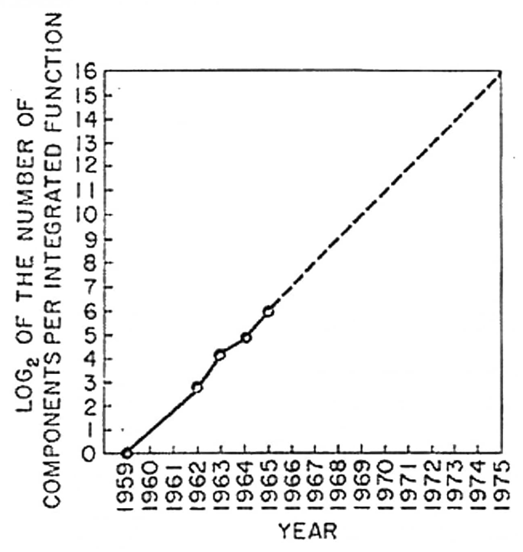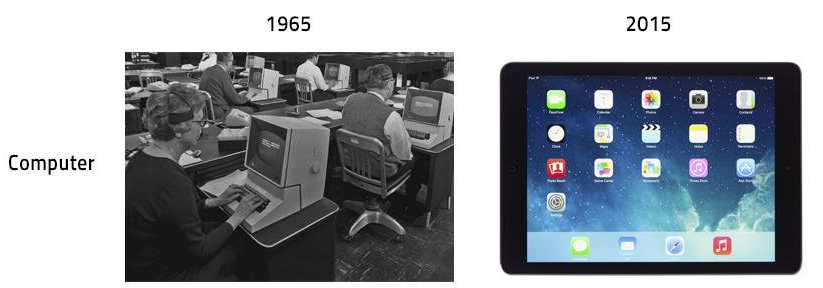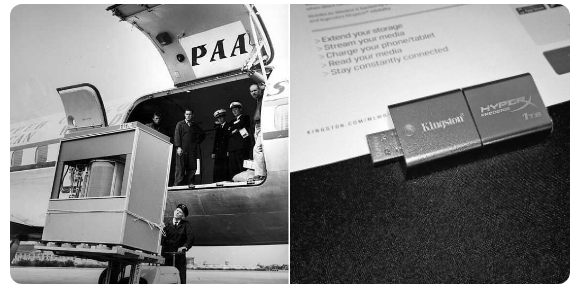What is moore’s law ? Learn with Video
Gordon Earle Moore is an American Business Man, Engineer and the Co-founder of Intel Corporation. He is also the author of Moore’s Law. He had born on 3 January 1929, in San Francisco. Gordon was working at Fairchild Semiconductor as Director of research and development (R&D) in 1965. An electronics magazine asked from Gordon Moore, what was going to be happening in the next ten year in the semiconductor industry. In an article, Moore said, “the semiconductor component will be double in the next two years”. The logarithmic graph shows that the number of transistors increased in every year.

Anybody can think that why our modern computer is better than the older one in terms of speed, processing etc. This is only done because of our powerful integrated chips which found in our Mobile phones, Tablets, our Automated cars etc. Billions of transistors are built on a single chip those are not seen by naked human eyes. Let’s take a look on a table which mentioned below.

Above table shows that as the number of transistors is increased in every two years and the size of the computer is reduced but the performance of the processor are increased day by day in terms of speed, memory space, minimize the size of a computer. We are witnessed about the shrinking of the size of the digital product in the last 50 years, which are incredible. Thanks to our fabrication technology which reduces the size of a transistor from micrometre to nanometre which is just like a miracle.
1971-10μm
1976-03μm
1982-1.5μm
1989-1μm
1995-0.5μm
1999-0.25μm
2000-180nm
2006-65nm
2011-32nm
2017-14nm
2017-5nm (By IBM, for research purpose only)

Moore’s law helps us to understand the remarkable concept of shrinking physical size and storage capacity in the last 50 years.

In the 1980s, very few people would think about smart phones.

Mobile applications, video games, weather forecasting, GPS tracker etc. are just a sample of life changing hacks in last few five years and this is done only by the power of Integrated Circuits (IC’s). The chip industry alive the prediction of Moore’s law which is lead by Intel Corporation. Wenisch says that Intel company capture the maximum area of the server chip market and their huge amount of customers are creative. To increase computing power, it is necessary to improve the design and algorithms of chips.
The network of transistors is responsible for the functioning of nearly all modern gadgets, from a digital alarm to a supercomputer. As the number of transistors in a chip is increased, as the network becomes more powerful.
With that, one way for chip designers to overcome the slow pace of advances in general purpose chips is to create a special processor instead. Graphical Processing Unit (GPU’s) is an example of this. The GPU is designed for faster manipulation and subsequent memory to accelerate the creation of images to display.
In recent years, due to advancement in technology, the number of GPU transistor has increased dramatically, making Moore’s law possible in that small area too.
Barrier of Moore’s Law
Gordon Moore predicts that the density and computing power of the transistor doubles in every twenty four months, since there were less than 100 transistors on integrated circuits.
Still, millions of transistors are integrated on a single chip. This amazing prophecy has encouraged some writers that “from time to time, people predict death of Moore’s Law. They say that Moore’s law will eventually end with some technical or scientific restrictions. Engineers and Scientists found a way to resolve this problem to continue Moore’s Law. In this section, we will discuss about the restrictions in Moore’s Law.
The length of gate is decreased as the node technology decreases. From past few decades we are expected the performance and speed of the IC’s should be increased. But, we observe that performance was decreased and the main reasons due to which the performance was decreases are heat sink, current leakage and power consumption. These factors reduce the product demand such as smart phones, flat-panel devices and laptop’s.
As the mobile device industry is growing, energy is always one of the most important issues. In addition, research and with the development of new energy storage materials and equipment, concerns around the world are increasing and research interest is increasing. Graphene, having unique two-dimensional carbon content, its high surface area, and good chemical stability, excellent electrical and thermal conductivity as well as being an excellent electrode material for energy conversion/ storage systems due to remarkably high mechanical strength is predicted. Actually, by increasing battery performance, more space may be available for processor performance. However, the generated heat will become another hindrance to the development of mobile devices, especially for smart phones, flat-panel PCs, and ultra-books that do not allow fan composition in the construction. These limitations will become another factor in further limiting Moore’s law in the future.
- How To Set Proxy In Web Browser
- Android Tips You Never Know
- What is Multithreading in Operating System ?
- Introduction of Call Center Software with List
- Generation of Computer | History of Computer
Transistors are just like on/off switches with a source (S), drain (D) and gate (G). Source (S) where the electrons come from, Drain (D) where the electron target and a gate (G) which primarily means through a channel controls the flow of electrons from that connects the source and the drain. When the length of the gate is smaller than 5 nanometres, however, the tunnling effect will start kicking in the game. Electron passes through the channels on their own without any driver voltage, because the source and the drain will be very close. Therefore, a transistor becomes unreliable as the source of basic data, because the probability of seamless transmission is approximately 50 percent. In other words, Heisenberg’s uncertainty theory is in action, because the location of electrons cannot be accurately predicted based on the uncertainty theory of Heisenberg. However, the tunnling effect will be regardless of the chemicals of the transistor content. In the last few years, many researchers have predicted Moore’s law, but have made the mistake of extrapolating on the basis of existing materials.
Due to high component density, consumer prices have come down. However, costs for producers follow a brief tendency: research and development, construction and testing become more and more expensive with each new generation. This observation is known as the law of the rock and is sometimes known as Moore’s second law Construction facility (Fab) also follows an exponential growth. Despite this exponential growth of facility costs, the cost per unit decreases at an exponential rate. Karl Rupp examined economic borders for the first semiconductor business. The summary of their results has already been published in. After this, Karl found that if the cost of a single fab is 0.02% of GWP (i.e., 2 = 0.0002), then due to economic reasons, the low growth of transistor count per-chip is likely to be around 2020.
There have been many papers and discussions about the life and death of Moore’s method, all of them are dealing with many technical questions within the semiconductor chip. However, no semiconductor chip can be present without the PCB board.
Higher bandwidth has become more important in today’s computing Personal computers, router, switches and game consoles require high bandwidth to meet the increasing performance demand for new applications. In addition, due to continuous scaling of integrated circuits technology confirming Moore’s prediction in recent years has largely been computational capability and therefore data processing capability has created the demand for high-speed communication in various components in the system. These systems extend the optical communication network spread all over the world, but all come down to the chip-to-chip communication in the same board The large flow of information inside and outside the chip has replaced simple input/output (I/O) drivers with sophisticated high-speed circuits, which in turn depend on reliable high bandwidth channels. Therefore, the onboard transmission line would become a remarkable bottleneck for the input/output of the semiconductor design.
Conclusion and Future of Moore’s Law
Moore’s law is not going to end in the same way as if it is closing gravity. Just because we have no doubling of the transistor on a chip every 18 months, it means that the progress will be completely stopped. This only means that the speed of reforms will be slow.
Multi-gate and Tri-gate transistors increase the life of Moore’s law for a period of time and these transistors are being used in various electronic gadgets. Multi-core processor also helps to extend the life of Moore’s law.
Yes, quantum computing is just like the long-term computing hope post Moore’s law, but it is likely that in a few decades, a computer will look completely different for those we use today. Whether it is new configurations of machines chips are made entirely of new materials or new types of sub-atomic research which open new ways to pack transistors on chips.
Reference
- P. E. Ross, “5 commandments,” IEEE Spectrum, vol. 40, no. 12, pp. 30–35, 2003.
- K. Rupp and S. Selberherr, “The economic limit to Moore’s law,” Proceedings of the IEEE, vol. 98, no. 3, pp. 351–353, 2010.
- R. R. Schaller, Moore’s law: past, present, and future,” IEEE Spectrum, vol. 34, no. 6, pp. 52–57, 1997.
- K.-Y. K. Chang, S. T. Chuang, N. McKeown, and M. Horowitz, “50 Gb/s 32 × 32 CMOS crossbar chip using asymmetric serial links,” in Proceedings of the Symposium on VLSI Circuits, pp. 19– 20, June 1999.
Submited By : Glory Pachnanda



























